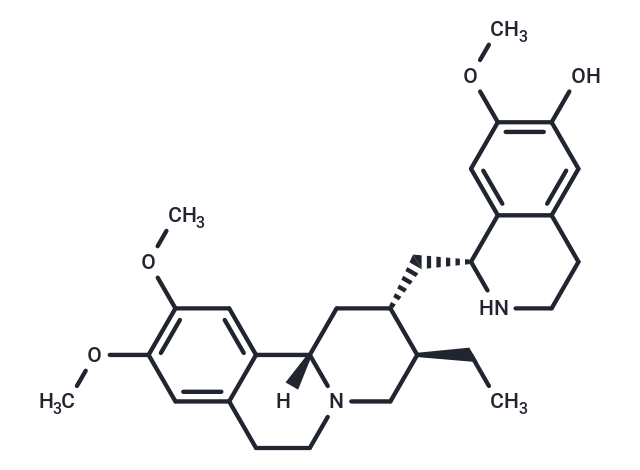Shopping Cart
- Remove All
 Your shopping cart is currently empty
Your shopping cart is currently empty

Cephaeline was highly active against protected primary CLL cells (relative IC50's 35nM ) and acted by repressing HIF-1α± and disturbing intracellular redox homeostasis.

| Pack Size | Price | Availability | Quantity |
|---|---|---|---|
| 1 mg | $189 | In Stock | |
| 5 mg | $372 | In Stock | |
| 10 mg | $549 | In Stock | |
| 25 mg | $869 | In Stock | |
| 50 mg | $1,170 | In Stock | |
| 100 mg | $1,580 | In Stock |
| Description | Cephaeline was highly active against protected primary CLL cells (relative IC50's 35nM ) and acted by repressing HIF-1α± and disturbing intracellular redox homeostasis. |
| In vitro | We compared the transcriptomes of primary CLL cells cocultured or not with protective bone marrow stromal cells (BMSCs) and found that oxidative phosphorylation, mitochondrial function, and hypoxic signaling undergo most significant dysregulation in non-protected CLL cells, with the changes peaking at 6-8 h, directly before induction of apoptosis. A subset of CLL patients displayed a gene expression signature resembling that of cocultured CLL cells and had significantly worse progression-free and overall survival. To identify drugs blocking BMSC-mediated support, we compared the relevant transcriptomic changes to the Connectivity Map database. Correlation was found with the transcriptomic signatures of the cardiac glycoside ouabain and of the ipecac alkaloids emetine and Cephaeline. These compounds were highly active against protected primary CLL cells (relative IC50's 287, 190, and 35 nM, respectively) and acted by repressing HIF-1α± and disturbing intracellular redox homeostasis. We tested emetine in a murine model of CLL and observed decreased CLL cells in peripheral blood, spleen, and bone marrow, recovery of hematological parameters and doubling of median survival (31.5 vs. 15 days, P = 0.0001). |
| Molecular Weight | 466.61 |
| Formula | C28H38N2O4 |
| Cas No. | 483-17-0 |
| Smiles | [H][C@@]12C[C@H](C[C@H]3NCCc4cc(O)c(OC)cc34)[C@@H](CC)CN1CCc1cc(OC)c(OC)cc21 |
| Relative Density. | 1.21g/cm3 |
| Storage | Powder: -20°C for 3 years | In solvent: -80°C for 1 year | Shipping with blue ice. | ||||||||||||||||||||||||||||||
| Solubility Information | Ethanol: 33.33 mg/mL (71.43 mM), Sonication is recommended. | ||||||||||||||||||||||||||||||
Solution Preparation Table | |||||||||||||||||||||||||||||||
Ethanol
| |||||||||||||||||||||||||||||||

Copyright © 2015-2025 TargetMol Chemicals Inc. All Rights Reserved.